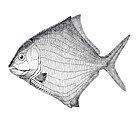| Eurynotoides Temporal range: | |
|---|---|
| Scientific classification | |
| Domain: | Eukaryota |
| Kingdom: | Animalia |
| Phylum: | Chordata |
| Class: | Actinopterygii |
| Order: | † Eurynotoidiformes |
| Family: | † Eurynotoididae |
| Genus: | † Eurynotoides Berg, 1940 |
| Species | |
| |
| Synonyms | |
| |
Eurynotoides is an extinct genus of prehistoric freshwater ray-finned fish [1] in the family Eurynotoididae of the order Eurynotoidiformes. It is known from the mid-late Permian of south-central Russia. [2] [3]







